Research
KEY STUDIES ON A WIDE RANGE OF HUMAN BRAIN FUNCTIONS
We study a wide range of questions in cognitive neuroscience including perception, attention, memory and motivation. Our research is conducted on normal young adults, older adults, and clinical populations. This wide range of techniques allow us to explore issues ranging from cognitive aging to functional connectivity.
A central focus of the research conducted in our lab is the integration of different neuroimaging methods including fast optical (EROS), optical spectroscopy (NIRS), functional MRI (fMRI) and event-related potentials (ERPs). By combining different methods, we get a more complete picture of the physiological events that occur in the brain during information processing. Optical methods, which record both neuronal signals (EROS) and slower signals related to hemodynamic activity (NIRS), play a pivotal role in this endeavor. This wide range of techniques allow us to explore issues ranging from cognitive aging to functional connectivity.
.jpg?Status=Master&sfvrsn=20e5fcbe_0)
OPTICAL DATA RECORDING: EROS & NIRS
Our laboratory uses near-infrared light to study two distinct signals the brain produces during cognitive activity; the Event Related Optical Signal (EROS) and Near Infrared Spectroscopy (NIRS). Via the use of near-infrared light (NIR), which penetrates several cm into the head, changes in the optical properties of brain tissue can aid in detecting neuronal activity. And with the appropriate methods, it is possible to localize the measurements to relatively small areas (less than 1 cc) and to distinguish signals from different depths. This yields good spatial resolution. Other advantages of these techniques are safety (because only a very small amount of non-ionizing radiation is used), relatively low costs, and versatility.
Representative Publications
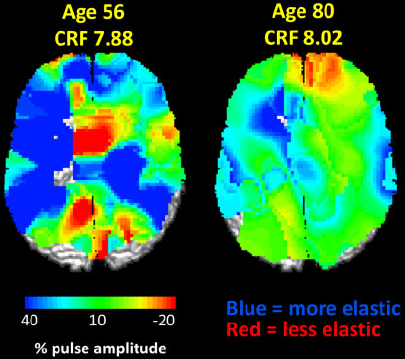 Cerebrovascular health is crucial for optimal brain functioning. And although arterial health declines naturally with age, these effects are mitigated by cardiorespiratory fitness. Therefore, we investigated arterial
health non-invasively using optical imaging in a older adults and related these pulse outcomes to cognition and level of physical fitness. Arterial stiffness was positively related to gray and white matter volumes. Pulse transit time (PTT) in
an artery supporting language processing positively related to verbal fluency, whereas PTT in a frontal artery positively related to working memory performance.
Cerebrovascular health is crucial for optimal brain functioning. And although arterial health declines naturally with age, these effects are mitigated by cardiorespiratory fitness. Therefore, we investigated arterial
health non-invasively using optical imaging in a older adults and related these pulse outcomes to cognition and level of physical fitness. Arterial stiffness was positively related to gray and white matter volumes. Pulse transit time (PTT) in
an artery supporting language processing positively related to verbal fluency, whereas PTT in a frontal artery positively related to working memory performance.
Taking the pulse of aging: Mapping pulse pressure and elasticity in cerebral arteries with diffuse optical methods. Fabiani, M., Low, K.A., Tan, C.H., Fletcher, M., Zimmerman, B., Schneider-Garces, N., Maclin, E.L., Chiarelli, A.M., Sutton, B.P., & Gratton, G. (2014). Psychophysiology.
 White matter lesions accompany healthy aging, are associated with a decline in fluid abilities and are related to vascular health. Assessing these factors as well as cerebral arterial stiffness across the adult lifespan,
we found that arterial stiffness partially mediated the relationship between age and white matter lesions and that white matter lesions partially mediated the relationship between arterial stiffness and fluid abilities. These results suggest that
cerebral arterial elasticity loss may influence cognition through white matter lesion presence.
White matter lesions accompany healthy aging, are associated with a decline in fluid abilities and are related to vascular health. Assessing these factors as well as cerebral arterial stiffness across the adult lifespan,
we found that arterial stiffness partially mediated the relationship between age and white matter lesions and that white matter lesions partially mediated the relationship between arterial stiffness and fluid abilities. These results suggest that
cerebral arterial elasticity loss may influence cognition through white matter lesion presence.
Optical Measures of Cerebral Arterial Stiffness are Associated with White Matter Signal Abnormalities and Cognitive Performance in Normal Aging. Tan, C.H., Low, K.A., Chiarelli, A.M., Fletcher, M., Burzynska, Z.A., Kong, T.S., Zimmerman, B., Maclin, E.L., Gratton, G. & Fabiani, M. (2019). Neurobiology of Aging.
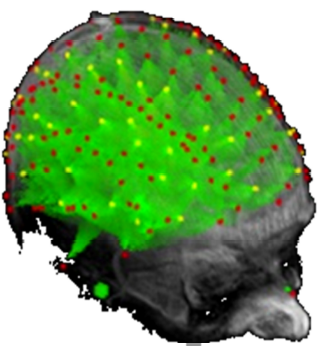 Fast optical imaging allows a unique window into understanding brain function because of its ability to localize neural activity and track neural activity on the millisecond scale. In this regard, it has blended benefits
of MRI and EEG data. However, it is limited in its penetration and is only able to view activity in the cortex. This paper reviews and summarizes major research using fast optical imaging.
Fast optical imaging allows a unique window into understanding brain function because of its ability to localize neural activity and track neural activity on the millisecond scale. In this regard, it has blended benefits
of MRI and EEG data. However, it is limited in its penetration and is only able to view activity in the cortex. This paper reviews and summarizes major research using fast optical imaging.
Fast optical imaging of human brain function. Gratton, G., & Fabiani, M. (2010). Frontiers in Human Neuroscience.
 Both arterial elasticity and brain volume decrease with age, however the relationship between these is not entirely clear. Here we assessed both global and local arterial elasticity using diffuse optical imaging (Pulse-DOT)
and related these measures to brain volumes across the adult lifespan. Global losses of arterial elasticity were related to global loss of brain volume across the lifespan. However, regional arterial elasticity was related to volumetric loss in
the same regions within an individual, highlighting the relationship between subclinical brain atrophy and cerebrovascular health and may help explain individual differences in atrophy.
Both arterial elasticity and brain volume decrease with age, however the relationship between these is not entirely clear. Here we assessed both global and local arterial elasticity using diffuse optical imaging (Pulse-DOT)
and related these measures to brain volumes across the adult lifespan. Global losses of arterial elasticity were related to global loss of brain volume across the lifespan. However, regional arterial elasticity was related to volumetric loss in
the same regions within an individual, highlighting the relationship between subclinical brain atrophy and cerebrovascular health and may help explain individual differences in atrophy.
Individual differences in regional cortical volumes across the life span are associated with regional optical measures of arterial elasticity. Chiarelli, A.M., Fletcher, M.A., Tan, C.H., Low, K.A., Maclin, E.L., Zimmerman, B., Kong, T., Gorsuch, A., Gratton, G., & Fabiani, M. (2017). NeuroImage
SMRI & FMRI
Our lab investigates changes in brain volume, cortical thinning, grey and white matter density, and white matter integrity by using a variety of cutting edge techniques (FreeSurfer, VBM, FSL etc). We also employ techniques of arterial spin labeling (ASL), optical imaging, and angiography to discover how vascular changes affect patterns of anatomical change. We seek to understand which life-style factors lead to various changes in brain anatomy. We also seek to understand the relationship between brain anatomy (sMRI), brain function (EEG, Optical Imaging, fMRI), and cognition (Gratton et al., 2009). Participants in our studies range from pre-mature infants to older adults.
Representative Publications
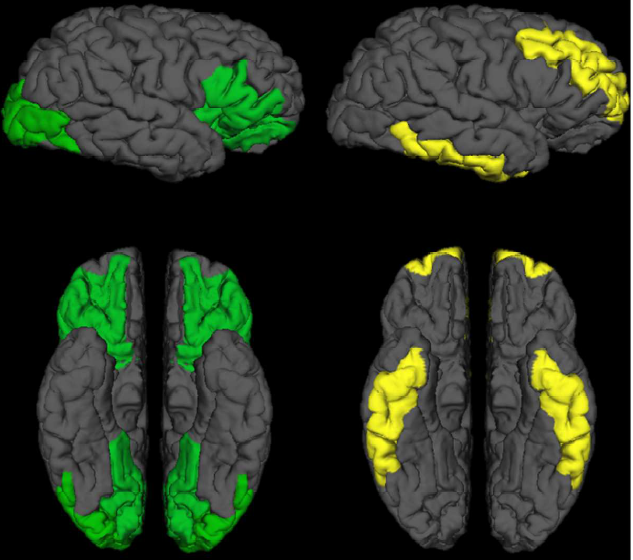 Cardiorespiratory fitness mitigates the effects of brain aging. However, precisely where the effect of fitness and the effects of age are located is relatively unexplored. We found that aging and fitness do not affect
entirely overlapping brain regions, such that regions most influenced by age are not those affected by fitness.
Cardiorespiratory fitness mitigates the effects of brain aging. However, precisely where the effect of fitness and the effects of age are located is relatively unexplored. We found that aging and fitness do not affect
entirely overlapping brain regions, such that regions most influenced by age are not those affected by fitness.
Comparing aging and fitness effects on brain anatomy. Fletcher, M.A., Low, K.A., Boyd, R., Zimmerman, B., Gordon, B.A., Tan, C.H., Schneider-Garces, N., Sutton, B.P., Gratton, G., & Fabiani, M. (2016). Frontiers in Human Neuroscience.
 Several human neuroimaging methods rely on the hemodynamic response - a linear increase in blood flow to a region following neuronal activity - to measure/infer brain activity. This response is performed by neurovascular
coupling, a mechanism connecting blood vessels to neurons, which may not be constant across the lifespan. We used multimodal imaging (fMRI, EEG, and EROS) to assess this and found that older and younger adults do not show a linear response and
that this effect is blunted for older individuals with low cardiorespiratory fitness.
Several human neuroimaging methods rely on the hemodynamic response - a linear increase in blood flow to a region following neuronal activity - to measure/infer brain activity. This response is performed by neurovascular
coupling, a mechanism connecting blood vessels to neurons, which may not be constant across the lifespan. We used multimodal imaging (fMRI, EEG, and EROS) to assess this and found that older and younger adults do not show a linear response and
that this effect is blunted for older individuals with low cardiorespiratory fitness.
Neurovascular coupling in normal aging: A combined optical, ERP and fMRI study. Fabiani, M., Gordon, B.A., Maclin, E.L., Pearson, M., Brumback, C.R., Low, K.A., McAuley, E., Sutton, B.P., Kramer, A.F., & Gratton, G. (2014). NeuroImage.
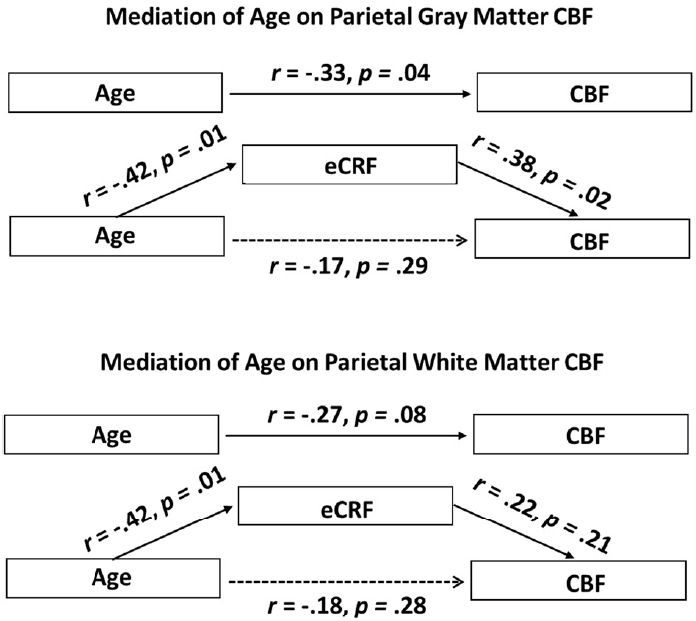 With age, the integrity of the arteries diminishes in the body and the brain. Maintaining high levels of cardiorespiratory fitness may mitigate
these effects and positively affect cognitive performance. The mechanisms by which fitness influences the cerebrovasculature were investigated here and show that blood flow in gray matter was positively correlated with fitness and negatively correlated
with age. Additionally, fitness fully mediated the effects of age on blood flow in gray, but not white, matter.
With age, the integrity of the arteries diminishes in the body and the brain. Maintaining high levels of cardiorespiratory fitness may mitigate
these effects and positively affect cognitive performance. The mechanisms by which fitness influences the cerebrovasculature were investigated here and show that blood flow in gray matter was positively correlated with fitness and negatively correlated
with age. Additionally, fitness fully mediated the effects of age on blood flow in gray, but not white, matter.
Cardiorespiratory fitness mediates the effects of aging on cerebral blood flow. Zimmerman, B. Sutton, B.P., Low, K.A., Tan, C.H., Schneider-Garces, N., Fletcher, M.A., Li, Y., Ouyang, C., Maclin, E.L., Gratton, G., & Fabiani, M. (2014). Frontiers in Aging Neuroscience.
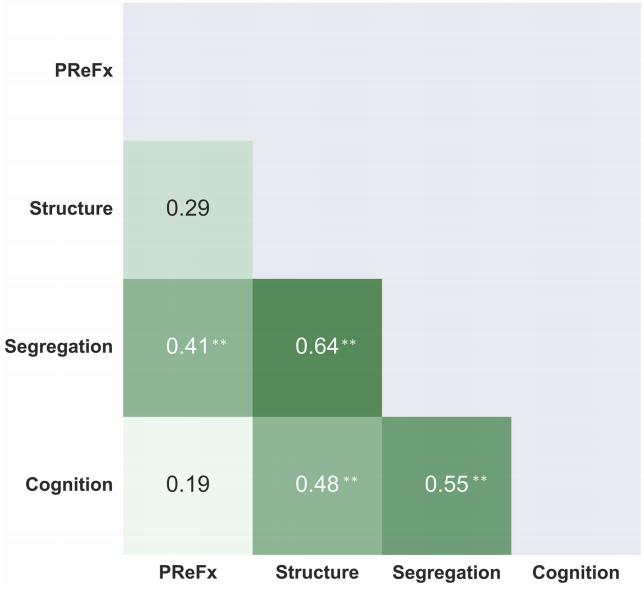 Age-related declines in cognition result from a varied cascade of lifestyle and biological factors, of which cerebral arterial elasticity is emerging as an important player. We propose an exploratory hierarchical framework
suggesting that aging reduces cerebral arterial elasticity, which negatively impacts brain structure, which results in differential functional network segregation in across the lifespan, and then eventually impacts various, but specific, domains
of cognition.
Age-related declines in cognition result from a varied cascade of lifestyle and biological factors, of which cerebral arterial elasticity is emerging as an important player. We propose an exploratory hierarchical framework
suggesting that aging reduces cerebral arterial elasticity, which negatively impacts brain structure, which results in differential functional network segregation in across the lifespan, and then eventually impacts various, but specific, domains
of cognition.
Age-related differences in functional brain network segregation are consistent with a cascade of cerebrovascular, structural and cognitive effects. Kong, T.S., Gratton, C., Low, K.A., Tan, C.H., Chiarelli, A., Fletcher, M.A., Zimmerman, B., Maclin, E.L., Gratton, G., & Fabiani, M. (2019). Network Neuroscience.
EEG/ERPs
Using spectral and time-frequency analysis of the EEG signal, our lab seeks to describe the oscillatory mechanisms underlying changes in attention and perception (8-12 Hz alpha oscillations) and cognitive control (4-8 Hz theta oscillations). In addition, time-locked EEG activity, or ERPs (event-related potentials), has great temporal resolution, which makes it extremely useful for studying the time-course of neural activity after stimulation or in preparation for a response. EEG/ERPs can also be recorded in a variety of populations, including children, older adults, and clinical populations.
Representative Publications
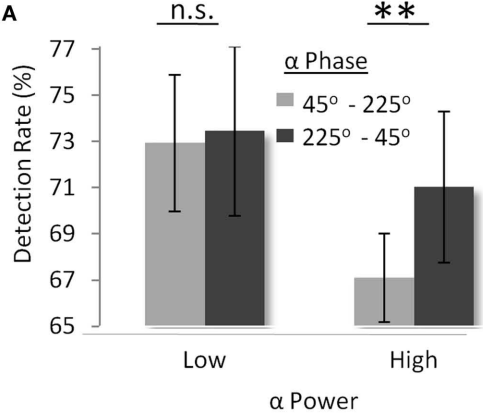 EEG recordings reveal that the phase of prestimulus alpha oscillations can predict visual detection and stimulus-related activation during a metacontrast masking paradigm. Based on these findings and others, we outline
a theory of cortical inhibition in which alpha power reflects a “pulsed inhibition” of cortical activity that modulates visual awareness.
EEG recordings reveal that the phase of prestimulus alpha oscillations can predict visual detection and stimulus-related activation during a metacontrast masking paradigm. Based on these findings and others, we outline
a theory of cortical inhibition in which alpha power reflects a “pulsed inhibition” of cortical activity that modulates visual awareness.
To See or Not to See: Pre-stimulus Alpha Phase Predicts Visual Awareness. Mathewson, K., Gratton, G., Fabiani, M., Beck, D.M., & Ro, A. (2009). The Journal of Neuroscience.
 EEG and the event-related optical signal (EROS) were concurrently recorded while participants performed a visual target detection task, in order to examine the relationship between fronto-parietal activity and posterior
alpha oscillations. By integrating these two techniques, we concluded that activity in fronto-parietal networks modulates posterior alpha power, and consequently, visual awareness.
EEG and the event-related optical signal (EROS) were concurrently recorded while participants performed a visual target detection task, in order to examine the relationship between fronto-parietal activity and posterior
alpha oscillations. By integrating these two techniques, we concluded that activity in fronto-parietal networks modulates posterior alpha power, and consequently, visual awareness.
Dynamics of alpha control: Fronto-parietal modulators of preparatory alpha oscillations revealed with combined EEG and event-related optical signals (EROS). Mathewson, K., Beck, D.M., Ro, T., Maclin, E.L., Low, K.A., Fabiani, M., Gratton, G. (2014). Journal of Cognitive Neuroscience.
 We investigated a proposed neural correlate of consciousness (NCC), the P3b ERP component, by administering a probe-mediated binocular rivalry task. Results suggested that the P3b latency reflects updates in consciousness,
not necessarily stimulus processing, and that P3b amplitude predicts how quickly this update occurs.
We investigated a proposed neural correlate of consciousness (NCC), the P3b ERP component, by administering a probe-mediated binocular rivalry task. Results suggested that the P3b latency reflects updates in consciousness,
not necessarily stimulus processing, and that P3b amplitude predicts how quickly this update occurs.
Regulating the Access to Awareness: Brain activity Related to Probe-related and Spontaneous Reversals in Binocular Rivalry. Metzger, B.A, Mathewson, K.E., Tapia, E., Fabiani, M., Gratton, G., & Beck, D.M. (2017). Journal of Cognitive Neuroscience.
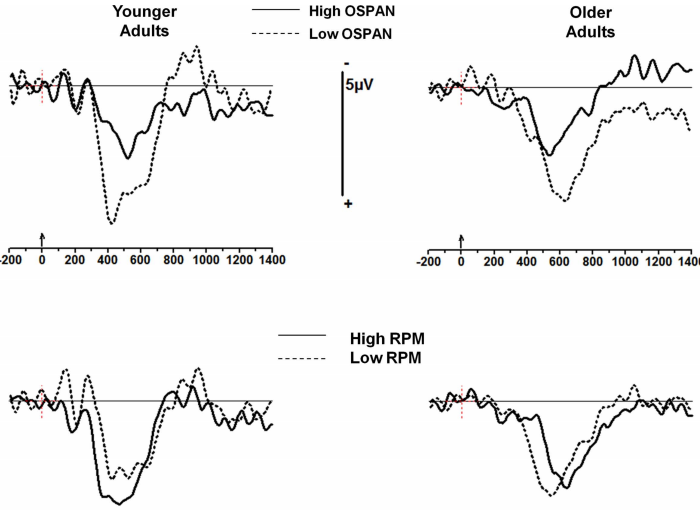 In spite of cognitive aging, there still exists great variability among older adults in their cognitive abilities. To investigate the neural phenomena
underlying this variability in performance, we examined the association between operation-span (OSPAN) scores and ERPs elicited during a choice reaction time task. We found that, among those with high OSPAN scores, irrespective of age group, P3b
amplitudes to changes in stimulus sequence were reduced, hinting at a superior ability to track stimulus sequencing. Additionally, among those with low cognitive flexibility, larger frontal P3s were observed.
In spite of cognitive aging, there still exists great variability among older adults in their cognitive abilities. To investigate the neural phenomena
underlying this variability in performance, we examined the association between operation-span (OSPAN) scores and ERPs elicited during a choice reaction time task. We found that, among those with high OSPAN scores, irrespective of age group, P3b
amplitudes to changes in stimulus sequence were reduced, hinting at a superior ability to track stimulus sequencing. Additionally, among those with low cognitive flexibility, larger frontal P3s were observed.
Age-related changes in electrophysiological and neuropsychological indices of working memory, attention control, and cognitive flexibility. Brumback Peltz, C.R., Gratton, G., & Fabiani, M. (2011). Frontiers in Cognition.
AGING
It is well-documented that cognitive abilities such as working memory and attentional control change across the lifespan, and that individual differences in fitness, education and cognitive reserve predict a higher level of functioning in old age. Given the complex dynamics that contribute to cognition in older age, our research is guided by the GOLDEN Aging (Growth of Lifelong Differences Explains Normal Aging) framework (Fabiani, 2012), which proposes that normal aging is characterized by quantitative shifts in pre-existing individual differences. We investigate the factors that influence the healthy functioning of brain networks and employ converging neuroimaging methods to better understand the dynamics of these processes.
Representative Publications
 Cardiorespiratory fitness mitigates the effects of brain aging. However, precisely where the effect of fitness and the effects of age are located is relatively unexplored. We found that aging and fitness do not affect
entirely overlapping brain regions, such that regions most influenced by age are not those affected by fitness.
Cardiorespiratory fitness mitigates the effects of brain aging. However, precisely where the effect of fitness and the effects of age are located is relatively unexplored. We found that aging and fitness do not affect
entirely overlapping brain regions, such that regions most influenced by age are not those affected by fitness.
Comparing aging and fitness effects on brain anatomy. Fletcher, M.A., Low, K.A., Boyd, R., Zimmerman, B., Gordon, B.A., Tan, C.H., Schneider-Garces, N., Sutton, B.P., Gratton, G., & Fabiani, M. (2016). Frontiers in Human Neuroscience.
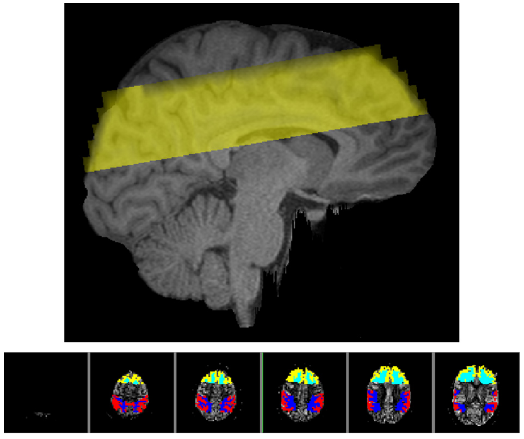 With age, the integrity of the arteries diminishes in the body and the brain. Maintaining high levels of cardiorespiratory
fitness may mitigate these effects and positively affect cognitive performance. The mechanisms by which fitness influences the cerebrovasculature were investigated here and show that blood flow in gray matter was positively correlated with
fitness and negatively correlated with age. Additionally, fitness fully mediated the effects of age on blood flow in gray, but not white, matter.
With age, the integrity of the arteries diminishes in the body and the brain. Maintaining high levels of cardiorespiratory
fitness may mitigate these effects and positively affect cognitive performance. The mechanisms by which fitness influences the cerebrovasculature were investigated here and show that blood flow in gray matter was positively correlated with
fitness and negatively correlated with age. Additionally, fitness fully mediated the effects of age on blood flow in gray, but not white, matter.
Cardiorespiratory fitness mediates the effects of aging on cerebral blood flow. Zimmerman, B. Sutton, B.P., Low, K.A., Tan, C.H., Schneider-Garces, N., Fletcher, M.A., Li, Y., Ouyang, C., Maclin, E.L., Gratton, G., & Fabiani, M. (2014). Frontiers in Aging Neuroscience.
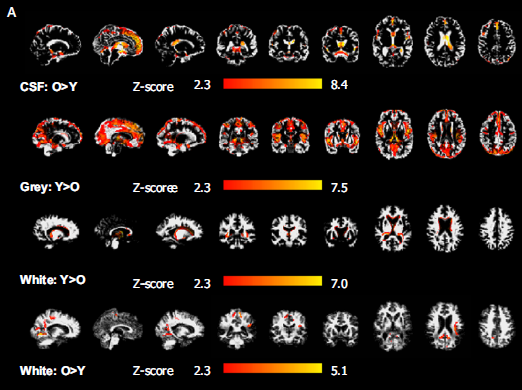 Both cardiorespiratory fitness and education have protective benefits against cognitive impairments with age. They may also affect age-related volume loss in brain tissue. We found that fitness and education were
both correlated with cognitive performance. However, in the brain, fitness and education did not affect overlapping areas: fitness predicted preserved gray matter in medial‐temporal, parietal, and frontal areas while education predicted preserved
white matter in inferior frontal areas.
Both cardiorespiratory fitness and education have protective benefits against cognitive impairments with age. They may also affect age-related volume loss in brain tissue. We found that fitness and education were
both correlated with cognitive performance. However, in the brain, fitness and education did not affect overlapping areas: fitness predicted preserved gray matter in medial‐temporal, parietal, and frontal areas while education predicted preserved
white matter in inferior frontal areas.
Neuroanatomical correlates of aging, cardiopulmonary fitness level, and education. Gordon, B., Rykhlevskaia, E., Brumback, C.R., Lee, Y., Elavsky, S., Konopack, J.F., McAuley, E., Kramer, A.F., Colcombe, S., Gratton, G., & Fabiani, M. (2008). Psychophysiology.
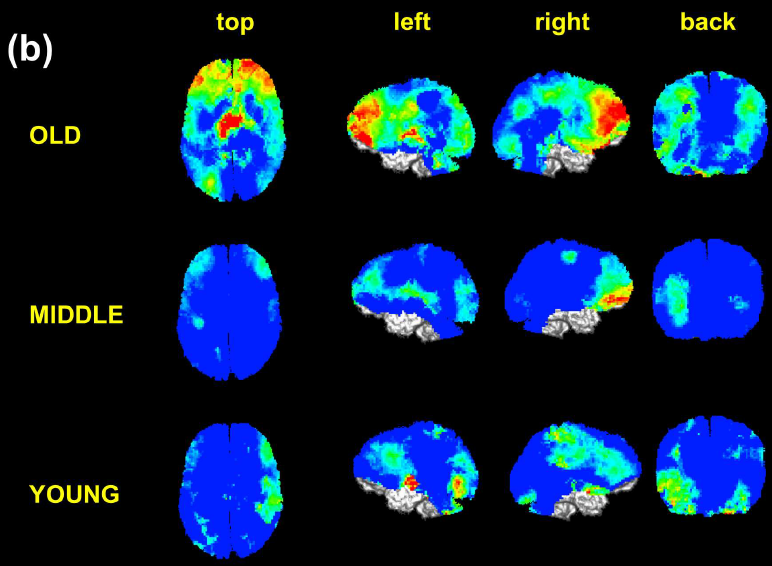 Cerebrovasculature integrity is important for neural and cognitive functioning across the lifespan. Diffuse optical imaging can be used to measure the health of the cerebral arteries noninvasively. This study replicated
and extended the results of Fabiani et al. (2014) using adults aged 18-75, showing that cerebral pulse amplitude and pulse pressure are correlated across the adult lifespan. New analyses showed that higher working memory task performance (operation
span; OSPAN) was associated with greater localized arterial compliance in frontoparietal cortex, but not with global arterial compliance.
Cerebrovasculature integrity is important for neural and cognitive functioning across the lifespan. Diffuse optical imaging can be used to measure the health of the cerebral arteries noninvasively. This study replicated
and extended the results of Fabiani et al. (2014) using adults aged 18-75, showing that cerebral pulse amplitude and pulse pressure are correlated across the adult lifespan. New analyses showed that higher working memory task performance (operation
span; OSPAN) was associated with greater localized arterial compliance in frontoparietal cortex, but not with global arterial compliance.
Mapping Cerebral Pulse Pressure and Arterial Compliance over the Adult Lifespan with Optical Imaging. Tan, C.H., Low, K.A., Zimmerman, B., Fletcher, M., Gratton, G., & Fabiani, M. (2017). PLOS One.
PERCEPTION
Our lab has a long history of investigating the processes by which or sensory perception of the world is boosted by attention (e.g. Gratton, 1997). We are interested in how moment to moment changes in the state of our brain influence how we perceive the world. For instance, a current lab focus is on the influence of ongoing brain activity on subsequent processing of information. We have found that the power and, importantly, the phase of ongoing alpha oscillations can predict subjects’ awareness of a subsequent flash of light (Mathewson et al., 2009). We have also localized the underlying sources of these alpha oscillations with simultaneous EROS and EEG recording during a similar task (Mathewson et al., 2014). We have further found that by entraining ongoing brain oscillations with rhythmic visual stimulation, one can control the ongoing phase of these oscillations, creating waves in the ongoing stream of consciousness (Mathewson et al., 2010, 2012).
Representative Publications
 EEG recordings reveal that the phase of prestimulus alpha oscillations can predict visual detection and stimulus-related activation during a metacontrast masking paradigm. Based on these findings and others, we outline
a theory of cortical inhibition in which alpha power reflects a “pulsed inhibition” of cortical activity that modulates visual awareness.
EEG recordings reveal that the phase of prestimulus alpha oscillations can predict visual detection and stimulus-related activation during a metacontrast masking paradigm. Based on these findings and others, we outline
a theory of cortical inhibition in which alpha power reflects a “pulsed inhibition” of cortical activity that modulates visual awareness.
To See or Not to See: Pre-stimulus Alpha Phase Predicts Visual Awareness. Mathewson, K.E., Gratton, G. Fabiani, M., Beck, D.M., & Ro, A. (2009). The Journal of Neuroscience.
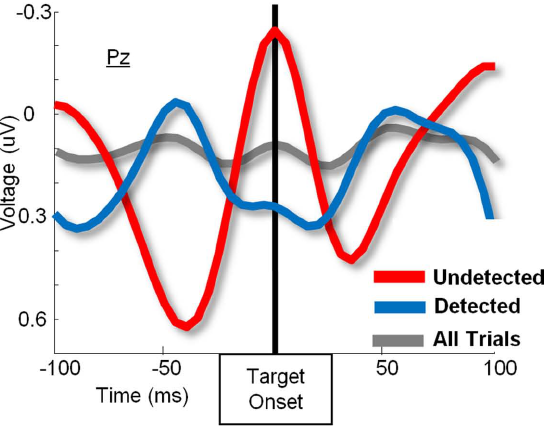 In this article, we review the role of EEG alpha oscillations in visual attention, with a focus on the role of alpha as indexing a “pulsed-inhibition” of brain activity. That is, alpha appears to modulate
neural activity via alternating microstates of inhibition and excitation. Furthermore, evidence suggests alpha can be entrained to rhythmic environmental stimuli, indicating that stimuli are preferentially processed depending on the phase of alpha.
Further implications of this “pulsed-inhibition” account of alpha for conscious experience are also discussed.
In this article, we review the role of EEG alpha oscillations in visual attention, with a focus on the role of alpha as indexing a “pulsed-inhibition” of brain activity. That is, alpha appears to modulate
neural activity via alternating microstates of inhibition and excitation. Furthermore, evidence suggests alpha can be entrained to rhythmic environmental stimuli, indicating that stimuli are preferentially processed depending on the phase of alpha.
Further implications of this “pulsed-inhibition” account of alpha for conscious experience are also discussed.
Pulsed Out of Awareness: EEG Alpha oscillations represent a pulsed inhibition of ongoing cortical processing. Mathewson, K.E., Lleras, A., Beck, D.M., Fabiani, M., Ro, T., & Gratton, G. (2011). Frontiers in Perception Science.
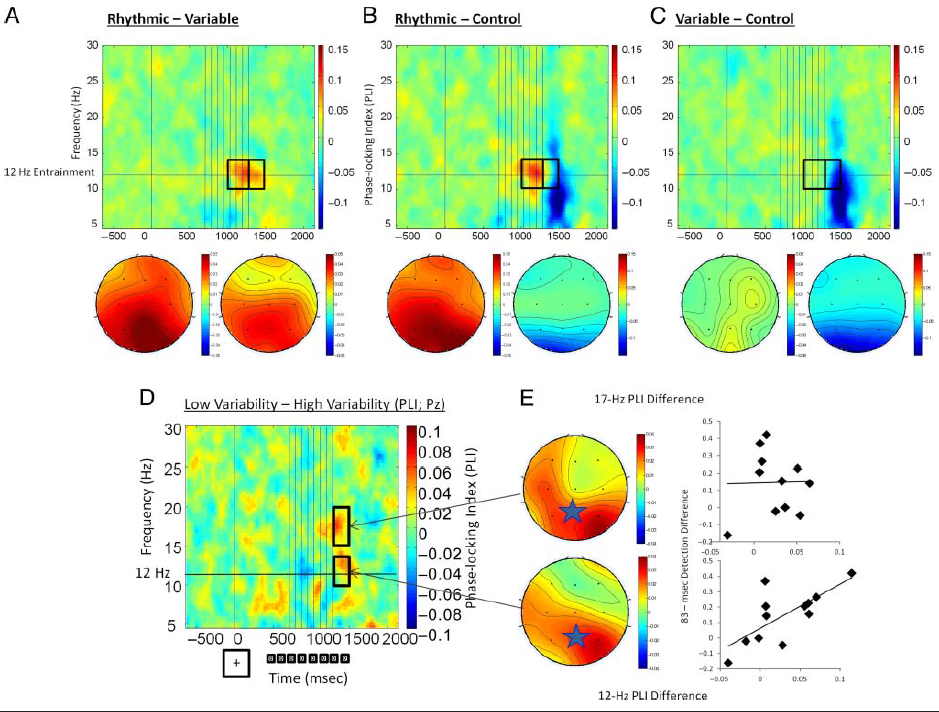 For the first time in humans, we demonstrate that the phase of ongoing neural oscillations cannot only be entrained to rhythmic visual stimuli but that the resulting phase-locked fluctuations in excitability lead to simultaneous
fluctuations in visual awareness. These data provide further support for the role of posterior alpha as a “pulsed-inhibitor” of ongoing cortical activity and reveal a mechanism underlying the modulation of attention and perception.
For the first time in humans, we demonstrate that the phase of ongoing neural oscillations cannot only be entrained to rhythmic visual stimuli but that the resulting phase-locked fluctuations in excitability lead to simultaneous
fluctuations in visual awareness. These data provide further support for the role of posterior alpha as a “pulsed-inhibitor” of ongoing cortical activity and reveal a mechanism underlying the modulation of attention and perception.
Making waves in the stream of consciousness: Entraining oscillations in EEG Alpha and fluctuations in visual awareneses with rhythmic visual stimulation. Mathewson, K.E., Prudhomme, C., Helwig, N.E., Fabiani, M., Beck, D.M., Lleras, A., & Gratton, G. (2012). Journal of Cognitive Neuroscience.
 We explore the putative feedforward/feedback mechanisms underlying single-pulse transcranial magnetic stimulation-induced (sTMS) visual suppression by C1 ERP component latency. Our results did not allow us to definitively
attribute sTMS-induced visual suppression to the disruption of either feedforward or feedback processes. We conclude that when delineating the source of TMS suppression effects, one should exercise caution when interpreting different bodies of
literature, which often use different stimuli.
We explore the putative feedforward/feedback mechanisms underlying single-pulse transcranial magnetic stimulation-induced (sTMS) visual suppression by C1 ERP component latency. Our results did not allow us to definitively
attribute sTMS-induced visual suppression to the disruption of either feedforward or feedback processes. We conclude that when delineating the source of TMS suppression effects, one should exercise caution when interpreting different bodies of
literature, which often use different stimuli.
Examining the role of feedback in TMS-induced visual suppression: A cautionary tale. Center, E.G., Fabiani, M., Gratton, G., & Beck, D.M. (2019). Consciousness and Cognition.
COGNITIVE CONTROL
One’s ability to modify attentional biases in the service of goal-directed behaviors, generate and maintain mental representations of task goals, and ignore task-irrelevant distractors characterizes cognitive control (Gratton et al., 2018). By integrating insights from various neuroimaging modalities (structural and functional MRI, optical imaging, and EEG/ERPs), we investigate how changes in these processes across the lifespan are reflected in changes in the brain’s structure and function.
Representative Publications
 It was found that by using only electrophysiological measures (alpha power, ERSPs, and ERPs) collected during training of a complex video game, Space Fortress, we could subsequently predict variance in learning rate and
transfer to other tasks. Therefore, cognitive control, as manifested in alpha and delta EEG oscillations, can forecast improvements in cognitive performance.
It was found that by using only electrophysiological measures (alpha power, ERSPs, and ERPs) collected during training of a complex video game, Space Fortress, we could subsequently predict variance in learning rate and
transfer to other tasks. Therefore, cognitive control, as manifested in alpha and delta EEG oscillations, can forecast improvements in cognitive performance.
Different Slopes for Different Folks: Alpha and Beta EEG Power Predict Subsequent Video Game Learning Rate and Transfer. Mathewson, K.E., Basak, C., Maclin, E.L., Low, K.A., Boot, W.R., Kramer, A.F., Fabiani, M., & Gratton, G. (2012). Psychophysiology.
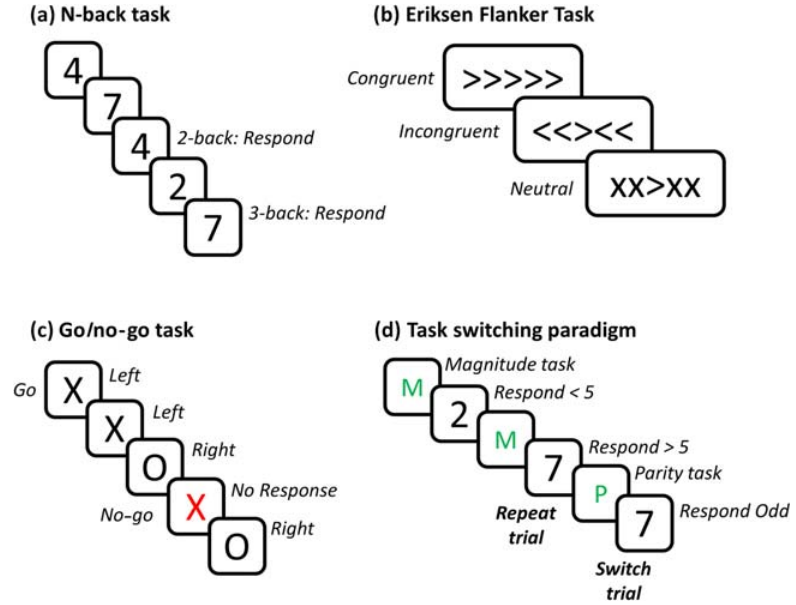 Here, we review extant literature on cognitive control, with an emphasis on findings from neuroimaging studies (specifically, electrophysiological, fMRI, and optical data). We provide overviews of theories of cognitive
control and tasks commonly used to assess it, insights from neuroimaging studies on the neural substrates and networks implicated in control processes, and open questions in the literature.
Here, we review extant literature on cognitive control, with an emphasis on findings from neuroimaging studies (specifically, electrophysiological, fMRI, and optical data). We provide overviews of theories of cognitive
control and tasks commonly used to assess it, insights from neuroimaging studies on the neural substrates and networks implicated in control processes, and open questions in the literature.
Dynamics of cognitive control: Theoretical bases, paradigms, and a view for the future. Gratton, G., Cooper, P., Fabiani, M., Carter, C., & Karayanidis, F. (2018). Psychophysiology.
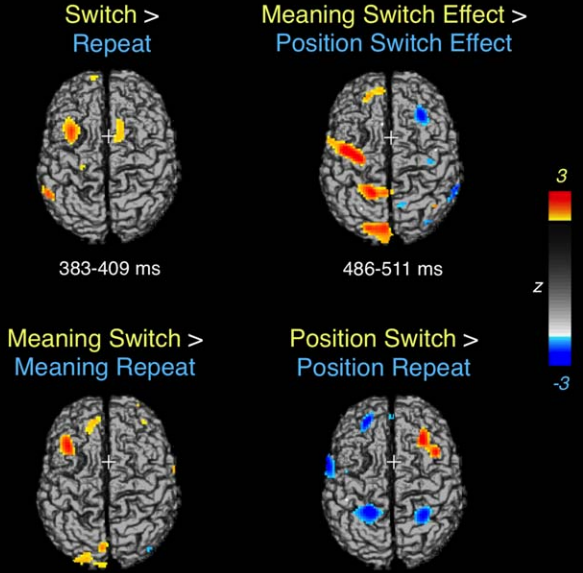 By integrating neuroanatomical, electrophysiological, and optical imaging data, we were able to describe the spatiotemporal dynamics of preparatory control in middle-aged to older adults during a task-switching task.
Critically, corpus callosum volume predicted task-dependent connectivity between the left and right middle frontal gyrus, strongly suggesting that this functional coupling, supported by the brain’s underlying structural integrity, is integral
to the ability to shift processing across hemispheres.
By integrating neuroanatomical, electrophysiological, and optical imaging data, we were able to describe the spatiotemporal dynamics of preparatory control in middle-aged to older adults during a task-switching task.
Critically, corpus callosum volume predicted task-dependent connectivity between the left and right middle frontal gyrus, strongly suggesting that this functional coupling, supported by the brain’s underlying structural integrity, is integral
to the ability to shift processing across hemispheres.
Shedding light on grey(ing) areas: Connectivity and task switching dynamics in aging. Baniqued, P. Low, K.A., Fletcher, M.A., Gratton, G., & Fabiani, M. (2018). Psychophysiology.
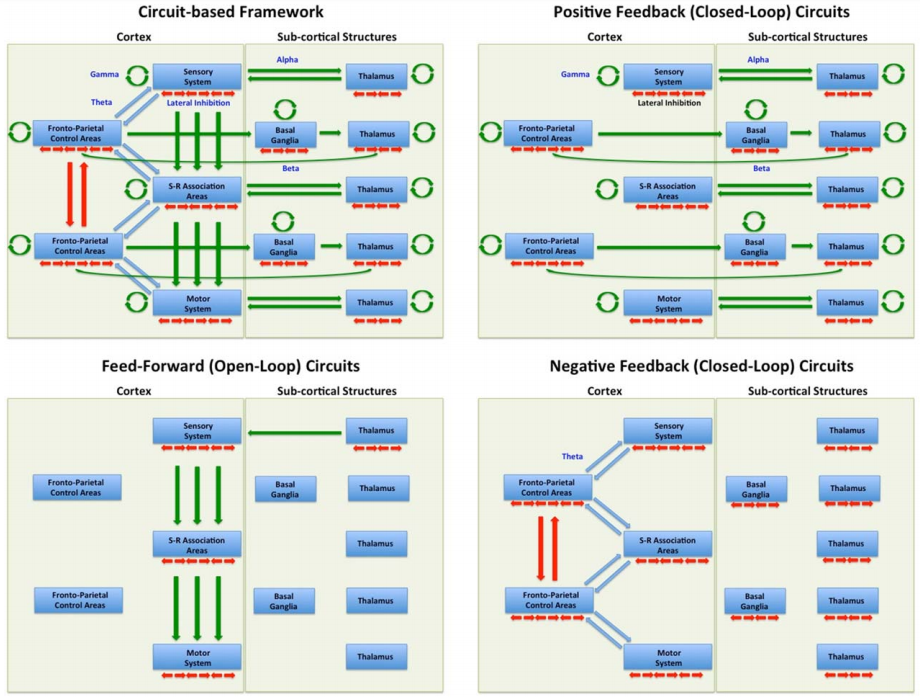 A framework for understanding the architecture of human information processing and its flexibility (cognitive control) is proposed. Three types of circuits (open, positive feedback, and negative feedback circuits) and
their associated oscillatory activities are thought to underlie the proposed cognitive architecture in which circuit interactions support either the preservation or disruption of mental representations, depending on task demands.
A framework for understanding the architecture of human information processing and its flexibility (cognitive control) is proposed. Three types of circuits (open, positive feedback, and negative feedback circuits) and
their associated oscillatory activities are thought to underlie the proposed cognitive architecture in which circuit interactions support either the preservation or disruption of mental representations, depending on task demands.
Brain reflections: A circuit-based framework for understanding information processing and cognitive control. Gratton, G. (2018). Psychophysiology.
Cognitive Neuroimaging Lab